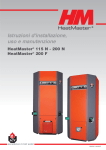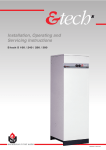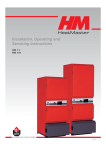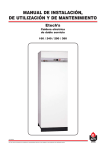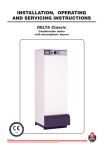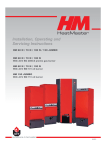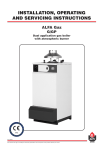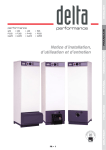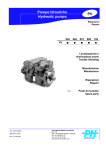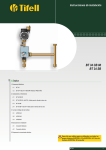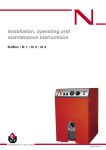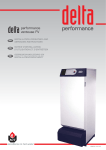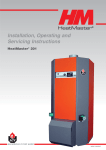Download ACV Alfa G Specifications
Transcript
delta performance Combination boiler 25 / 35 / 45 / 55 delta performance F25 / F35 / F45 / F55 G25 / G35 / G45 / G55 Installation, Operating and Servicing Instructions excellence in hot water 11/06/2004 - 66400000 INDEX 1 1 INTRODUCTION 2 1.1 1.2 1.3 1.4 People who should read these instructions Symbols Applicable standards Warnings 2 2 2 2 2 INSTALLATION 3 2.1 2.2 2.3 2.4 Boiler room Connections Oil supply Electrical connections 3 3 5 6 3 STARTING UP 7 3.1 3.2 Filling the heating and domestic hot water circuits Troubleshooting the burner 7 7 4 SERVICING 7 4.1 4.2 4.3 4.4 4.4 4.6 4.7 Recommendation Servicing the gas boiler Servicing the oil boiler Servicing the safety devices Servicing the burner Emptying the boiler Spare parts 7 7 7 7 8 8 8 5 DESCRIPTION 9 5.1 5.2 5.3 Overview Description of operation Build features 9 9 10 6 TECHNICAL SPECIFICATIONS 11 6.1 6.2 6.3 6.4 6.5 6.6 Effective dimensions Maximum operating conditions Domestic hot water performance Boiler without burner Boiler with ACV oil burner Boiler with ACV BG 2000-S gas burner 11 11 11 11 12 13 7 USER GUIDE 14 7.1 7.2 Using the boiler Boiler room 14 15 1.1 INTRODUCTION PEOPLE WHO SHOULD READ THESE INSTRUCTIONS These instructions should be read by: 1.2 - the specifying engineer the installation engineer the user servicing technicians SYMBOLS The following symbols are used in these instructions: Essential to ensure that the system works properly. Essential for personal safety and environmental protection. Danger of electrocution. Danger of burns. 1.3 APPLICABLE STANDARDS The products have been granted the “EC” certificate in accordance with the standards in force in different countries (European Directives, 92/42/EEC “efficiency” and 90/396/ECC “gas devices”). These products have also been granted the Belgian “HR+”(gas boilers) and “OPTIMAZ” (oil boilers) marks. 1.4 WARNINGS These instructions are an integral part of the equipment to which they refer and the user must be provided with a copy. The product must be installed and serviced by qualified engineers, in compliance with current standards. ACV cannot accept liability for any damage resulting from incorrect installation or from the use of components or fittings not specified by ACV. Any failure to follow instructions relating to tests and test procedures may result in personal injury or risks of pollution. Because of their high level of performance our boilers produce flue gas discharge at low temperatures. This can cause condensation in some chimney flues. Your installing engineer will advise you whether you need to install a flue pipe in your chimney. 2 N.B. ACV reserves the right to change the technical specifications and components of its products without prior notice. 2 2.1 INSTALLATION BOILER ROOM 2.2.2 2.2.2.1 Examples of basic circuit configurations The drain cock and safety valve must be connected to the waste water disposal system. 2.1.1 ACCESSIBILITY The boiler room must be large enough to allow proper access to the boiler. The following minimum distances (mm) around the boiler are required: - at the front - at the rear 500 150 - at the sides - above CENTRAL HEATING CONNECTION 100 700 9 2.1.2 VENTILATION The boiler room must be fitted with top and bottom vents as shown in the table below. 2.2 3 CONNECTIONS 6 5 2.2.1 CHIMNEY CONNECTION The boiler can be connected to a suitable flue or to chimney by a metal pipe rising at an angle from the boiler to the chimney. It must be easily removable in order to give access to the flue pipes when servicing the boiler. A draught regulator must be installed on the chimney in order to stabilise negative pressure. 10 Because of their high level of performance our boilers produce flue gas discharge at low temperatures. This can cause condensation in some chimney flues. Your installing engineer will advise you whether you need to install a flue pipe in your chimney. Top vent Bottom vent Draught regulator Inspection cover Chimney height Chimney diameter Fig. 2: Hydraulic diagram showing circulator controlled by a room thermostat. 1. 2. 3. 4. 5. 6. 7. 8. 9. 10. F E A. B. C. D. E. F. 7 4 2 2.1.3 BASE The boiler must be laid on a base made of non-combustible materials. 9 Motorised 3-way manual mixer valve Safety valve preset to 3 bar with pressure gauge Circulator Non-return valve System filling valve Expansion tank Room thermostat (fig. 2) ACV 13 controller (see controller kit on page 5) (fig. 3) Central heating isolation valve Discharge outlet C A 9 B 9 D 2 Fig. 1: Boiler room ventilation and chimney connection Ventilation 25-F25 35-F35 45-F45 55-F55 G25 G35 G45 8 4 3 1 G55 6 Min. fresh air requirement m3/h 50/66 66/90 84/122 100/138 45 63 81 99 Top vent (A) dm2 2 2 2 2 1,5 1,5 1,5 1,5 Bottom vent (B) dm2 1,5 1,5 1,5 1,5/2,1 1,5 1,5 1,5 1,7 5 Chimney E = 5m Ø min.F mm 158/182 182/213 208/248 226/266 160 189 215 236 E = 10m Ø min.F mm 133/153 153/179 175/209 190/223 135 159 181 199 E = 15m Ø min.F mm 130/138 138/162 158/188 172/202 130 143 163 179 Important Boilers must be installed by an approved engineer, in accordance with current local standards and regulations. 10 Fig. 3: Hydraulic diagram with motorised mixer valve 3 2 INSTALLATION 2.2.2.2 ACV hydraulic kit ACV offers an optional pre-assembled hydraulic kit comprising: - A circulator. - A motorised 3-way manual valve. - Connecting pipes including an optional second circuit. - Two isolation valves. - Connectors for mounting the safety valve with pressure gauge and the filling valve to the right or left of the expansion tank. 2.2.2.3 Discharge The drain cock and safety valve must be connected to the waste water system in accordance with current regulations. Fig. 4: Assembly with the ACV hydraulic kit 2.2.3 DOMESTIC HOT WATER CONNECTION 2.2.3.1 Pressure reducer If the water mains pressure is greater than 6 bar, a pressure reducer calibrated to 4.5 bar must be fitted. 5 2 7 4 8 1 2.2.3.2 Safety unit The tank safety unit must be ACV approved and calibrated to 7 bar. The valve discharge must be connected to the waste water system in accordance with current regulations. 9 6 2.2.3.3 Domestic hot water expansion tank Installing a hot water expansion tank avoids any risk of pressure surges due to waterhammer. 2.2.3.4 Hot water circulation If the tank is located a long way from the point of use, then installing a closed recirculation circuit ensures that a faster supply of hot water is always available. 2.2.3.5 1. 2. 3. 4. 5. 6. 7. 8. 9. Fig. 5a: Connection without thermostatic mixing valve Description Safety unit Pressure reducer Thermostatic mixing valve Hot water circulator Non-return valve Domestic hot water type expansion tank Inlet valve Draw-off valve Bleed valve 5 2 7 4 8 1 3 9 6 IMPORTANT As a safety measure against burns, we strongly advise installing a thermostatic mixing valve (recommended temperature: 60° C). This is available as an optional accessory Safty unit Pressure reducer Thermostatic mixing valve Expansion tank 4 Ø 3/4” Ø 3/4” Ø 3/4” 5 litres Fig. 5b: Connection with thermostatic mixing valve 2 2.2.4 INSTALLATION CONTROLLER KITS KIT 1: ACV 13.00 / Basic Basic kit for regulating initial flow temperature according to weather conditions. It comprises: a temperature regulator with analogue clock, wall-mounted water temperature sensor (-30/130° C), external sensor (-30/50° C), 3-pin servomotor SQY 31 230 V and an intermediate base. Fig. 5b: kit 1 KIT 1: ACV 13.00 / Standard Basic kit for regulating initial flow temperature according to weather conditions. It comprises: a temperature regulator with analogue clock, wall-mounted water temperature sensor (-30/130° C), external sensor (-30/50° C), 3-pin servomotor SQY 349,230 V and an intermediate base. Fig. 5b: kit 2 Wiring diagram for ACV controller kits (fig. 7) SQK 349 B2. B9. B5. P1. Wall-mounted temperature detector External sensor Analogue/digital room thermostat Central heating pump Y1/Y2/N. Mixing valve (SQK349) bl. n/z. br. Blue N Black Y2 Brown. Y1 230V P1 B5 B9 B3 B2 QAAD50 (QAAD70) QAC32 QAD22 bl n/z br 20 19 18 17 16 15 14 13 N 12 11 10 9 8 7 6 5 4 3 2 L1 1 230V / 50 Hz 20 19 18 17 16 15 14 13 N Y2 Y1 2.3 OIL SUPPLY 2.3.1 INSTALLATION WITHOUT RETURN 12 11 10 9 P1 8 7 6 B5 5 4 B9 3 B3 1 2 B2 Ø int. H (m) 8 mm 10 mm 0,5 10 20 1 20 40 1,5 40 80 2 H L1 Fig. 8a: Oil supply without return 100 INSTALLATION WITH RETURN L1 L (m) H Ø int. Ø int. H (m) 8 mm 10 mm 0 35 100 0,5 30 100 1 25 100 1,5 20 90 2 15 70 2 8 30 3,5 6 20 max 4m 2.3.2 60 max 4m L (m) Ø int. H L1 Fig. 8b: Oil supply with return from either top or bottom mounted tank 5 2 2.4 INSTALLATION ELECTRICAL CONNECTION It is important to switch the boiler off before carrying out any work. 2.4.1 DESCRIPTION OF POWER SUPPLY The boiler operates on single phase 230 V – 50 Hz. An on-off switch box with 6 A fuses must be fitted outside the boiler to allow power to be shut off during servicing and before any repairs are carried out on the boiler. 1 3 2 4 5 2.4.2 COMPLIANCE Boiler installation must comply with current local standards and legislation. 2.4.3 SAFETY The stainless steel tank must be earthed separately. 2.4.4 BURNER ELECTRICAL CONNECTION The burner is powered through a 3-core cable, which is plugged into the connector in the lower right hand corner of the burner chamber plate. Details of how to connect it up aregiven in the technical instructions for the burner. 10 N T1 T2 S3 B4 L1 M 1 1 2 C T M O 3 B 6 N O Fig. 9 Control panel 1. 2. 3. 4. 5. 6. 7. 8. 9. 10. 11. PH: N: M: VM 1: VM 2: PF: T: AL: CF: M. O. N. B. T. G. J. Boiler thermostat (60/90° C) On/off switch Summer/Winter selector switch Thermometer Controller (optional) Safety thermostat (95° C max.) Safety thermostat (103° C max.) Plug for power and control Central heating circulator connection Burner connection Room thermostat Phase Neutral Motor Magnetic valve 1 Magnetic valve 2 Oil preheating Ignition transformer Alarm Photoelectric cell CF M VM2 VM1 PF B 7 T AL PH N O 1 2 3 4 5 6 7 8 9 10 11 12 N B 2 10 M L1 B L1 N T1 T2 S3 B4 Fig. 10 b: Oil burner N T1 T2 S3 1 2 3 4 5 6 7 8 9 10 11 12 L1 N L1 N T1 T2 S3 M BV B N JGM G M 230V-50 Hz 6A 8 11 9 Fig. 10 a: Boiler wiring 6 10 L1 N B M V J N T1 T2 S3 B4 Fig. 10 c: Gas burner Brown Orange Black Blue Green-yellow Grey Yellow 3 3.1 STARTING UP FILLING THE HEATING AND DOMESTIC HOT WATER CIRCUITS 1. Fill the domestic hot water circuit and bring it up to pressure. 4 4.1 RECOMMENDATION ACV recommend that boilers should be serviced at least once a year. The burner must be serviced and tested by a competent engineer. 4.2 2. Fill the heating circuit taking care not to exceed the 2 bar pressure limit. 3. Bleed the air from the top of the boiler. 4. After bleeding the air out of the system, bring the pressure up to the static pressure (height) plus 0.5 bar: 1.5 bar = 10 m – 2 bar = 15 m. 5. Check the power connection, the boiler room ventilation and ensure that there are no leaks in the flue gas discharge pipes. 6. Set the thermostat (1) to between 60 and 90° C. 3 SERVICING THE BOILER 1 - Switch the power off at the mains switch outside the boiler and close the gas tap. 2 - Set the on/off switch on the control panel to the OFF position. 3 - Release and remove the chimney flue (1) to free the top of the boiler. 4 - Remove the jacket top (2) and lift off the flue reducer (3). 5 - Remove the baffles (4) from the flue pipes (5) for cleaning. Replace them if they are in poor condition. 6 - Remove the chamber plate (6). 7 - Brush the flue pipes (5). 8 - Clean the burner chamber (7) and the burner (8). 9 - Check the insulation on the chamber plate (6) IMPORTANT The hot water tank must be pressurised before the heating circuit is filled. 1 SERVICING 2 1. 2. 3. 4. 5. 6. 7. 8. Chimney flue Jacket cover Chimney flue reducer Baffles Flue pipes Chamber plate Combustion chamber Burner 1 2 3 Fig. 11: Control panel 7. 8. 9. 10. Set the Summer/Winter selector switch (3) to the desired position. Switch the on/off switch (2) to the ON position. Check the pressure of the gas supply when starting up. For the oil burner check the oil supply (and return). Carry out any bleeding, measuring and adjustment work which may be necessary. 5 3.2 4 TROUBLESHOOTING THE BURNER 3.2.1 ACV BG 2000-S GAS BURNER Please refer to the servicing and troubleshooting instructions for the burner. 6 8 7 3.2.2 ACV OIL BURNER Please refer to the servicing and troubleshooting instructions for the burner. Before carrying out any servicing or repair work, switch the power off at the mains switch fitted in the boiler room by the electrician. Fig. 12: Description of the main components which require servicing. 4.3 - 4.4 - - SERVICING THE OIL BOILER Switch the power off at the mains switch outside the boiler and close the oil inlet. Proceed following instructions 2 to 9 in paragraph (4.2 Servicing the gas boiler). SERVICING THE SAFETY DEVICES Check that all thermostats and safety devices are working properly: boiler thermostat, cut-off thermostat and manually reset safety thermostat. Check the safety valves on both the central heating and the hot water circuits. 7 4 SERVICING 4.5 SERVICING THE BURNER 4.5.1 OIL BURNER - Check the main filter on the oil line and clean it if necessary. Check the nozzle line: check, clean or change the nozzle and filter, check that it is clean and that the electrodes and flame holder are properly set. Replace the whole unit and check that the safety devices are working properly Adjust the combustion parameters. - 4.5.2 - 1 1 GAS BURNER Check and clean the burner and the electrodes. Check that the safety devices are working properly. 4.6 EMPTYING THE BOILER 4.6.1 EMPTYING THE PRIMARY CIRCUIT (CENTRAL HEATING): 1. Switch the power to the boiler off at the mains switch installed by the electrician. 2. Close the boiler system’s isolating valves (1). 3. Connect a hose to the drain cock (2). Make sure that it is properly attached. 4. Open the drain cock and let the hot water drain out. 2 Fig. 13a: Emptying the primary circuit 5. When the boiler is empty, return the valves to their initial positions 4.6.2 EMPTYING THE DOMESTIC HOT WATER TANK: 1. Switch the mains power to the boiler off at the external switch installed by the electrician. 2. Remove the pressure from the primary circuit. 3. Close valves (A) and (B). 4. Open valves (C) and (D) (first C then D). 5. Let the water drain away. 6. After emptying, return the valves to their initial positions. To allow the tank to be emptied, valve (C) must be situated at ground level. 4.7 SPARE PARTS Please refer to the specific document available from ACV or your distributor. 8 B A D C Fig. 13b: Emptying the hot water circuit 5 5.1 • • • • • • • • • DESCRIPTION OVERVIEW Combination boiler (central heating and domestic hot water). Designed for connection to a chimney. TANK-IN-TANK indirect storage type domestic hot water production. Fittings required to connect the hydraulic kit for feeding the heating circuit (available as an optional extra). Control panel with on/off switch, adjustable thermostat, thermometer, Summer/Winter selector and knockout for fitting ACV integrated control system (optional). DELTA Performance 25, 35, 45 and 55 models - with effective outputs adjustable between 22 and 62 kW - are shipped without burners. They can be fitted with most gas or oil burners available on the market. DELTA Performance F25, F35 and F45 models - with effective outputs adjustable between 22 and 54 kW - are shipped with an ACV BM R oil burner. DELTA Performance F55 models - with effective outputs adjustable between 45 and 62 kW - are shipped with an ACV BM oil burner. DELTA Performance G25, G35, G45 and G55 models - with effective outputs adjustable between 22.5 and 49 kW - are shipped with a BG 2000-S gas burner. 5.2 DESCRIPTION OF OPERATION 5.2.1 THE TANK-IN-TANK CONCEPT Fig. 14: Stainless steel domestic hot water tank The DELTA Performance series differs from traditional hot water producers in that it has a ring-shaped tank immersed in the primary fluid contained in the outer body. When hot water from the central heating system or the domestic hot water system is needed, the thermostat starts up the burner. The combustion gases quickly heat up the primary fluid, thus creating a natural circulation around the tank. 4 5.2.2 INDIRECTLY HEATING DOMESTIC HOT WATER This circulation allows easier heat exchange between the primary fluid and the domestic water, all over the tank surface. The corrugations on the inner and outer shells of the ring-shaped tank increase the area of heat exchange still further and thus speed up the process of heating the domestic water. 5.2.3 EASY TO SET AND SAFETY ASSURED With a single command, the water temperature of both the primary circuit and the domestic hot water circuit can be set by the adjustable thermostat situated underneath the tank in the primary circuit. A cut-off thermostat, placed on the top of the boiler automatically switches off the burner when the temperature of the water in the primary circuit reaches 95° C. A manually reset safety thermostat switches off the burner if the temperature reaches 103° C. 2 4 1 3 5 Fig. 15: Brief description of the boiler 1. Primary fluid 2. Domestic hot water 3. Combustion chamber 4. Control thermostat 5. Burner 9 5 5.3 DESCRIPTION BUILD FEATURES 5.3.1 OUTER BODY The outer body containing the primary fluid is made of STW 22 steel. 5.3.2 TANK-IN-TANK TYPE EXCHANGER ACCUMULATOR The ring-shaped inner tank with its large heating surface, used for producing domestic hot water, is built using Chrome/Nickel 18/10 stainless steel. It is corrugated all the way up to the top using an exclusive production process and entirely argon arc welded using the TIG (Tungsten Inert Gas) method. 5.3.3 COMBUSTION GAS CIRCUIT The combustion gas circuit is protected by a coat of paint. The combustion gas circuit comprises: 5.3.3.1 Flue pipes Depending on output, the various DELTA Performance models contain either 4 or 8 steel flue pipes with an inner diameter of 64 mm. Each pipe is fitted with a special steel baffle designed to improve heat exchange and reduce the flue gas temperature. 1. 2. 3. 4. 5. 6. 7. 8. 9. 10. 11. 12. 13. 14. 15. 16. 17. 18. 19. Inner ring-shaped tank containing the domestic hot water External body containing central heating circuit Insulation Jacket Flue pipes Baffles Thermostat adjustable between 60° and 90° C Lower central heating return Combustion chamber Chamber plate Emptying the boiler Upper central heating flow pipe and return Chimney connection Control panel Domestic hot water outlet Domestic cold water inlet Cut-off thermostat 95° C / Thermometer Manually reset 103° C safety thermostat Gas or oil burner 5.3.3.2 Combustion chamber All DELTA Performance models feature a fully water-cooled combustion chamber. 5.3.4 INSULATION The boiler body is fully insulated by rigid polyurethane foam with a high thermal insulation coefficient. This is sprayed onto the tank without using any CFCs. 5.3.5 JACKET The boiler is covered by a steel jacket which has been scoured and phosphated before being stove finished at 220° C. 13 17 4 15 7 14 12 16 18 5.3.6 BURNER DELTA Performance F25 and F35 boilers are shipped with the ACV BM R 31 gas burner, F45 boilers are fitted with the ACV BM R 51 burner and the F55 boiler can be fitted with the ACV BM 101 burner. These new generation burners incorporate the latest technological developments and meet all safety, efficiency and clean combustion requirements. They come fitted with a preheating device, with the exception of the BM 101. DELTA G25, G35, G45 and G55 performance boilers all ship with the ACV BG 2000-S gas burner. 1 2 3 5 6 IMPORTANT For assembly, the various settings, start-up and servicing please see the technical instructions which come with the burner. 7 10 8 9 19 11 5.3.7 1 2 3 4 5 - CONTROL PANEL (FIG. 17) Thermostat adjustable between 60° and 90° C On/off switch Summer/Winter selector switch Thermometer Knockout for control system (optional). Fig. 16: The boiler 1 3 2 4 Fig. 17: Control panel 10 5 6 6.1 TECHNICAL SPECIFICATIONS EFFECTIVE DIMENSIONS Units are shipped fully assembled, tested and packed on a timber base with shockproof edges and protected by a heat-shrunk plastic film. On reception and after unpacking, check the equipment for any damage. For transportation purposes, please see the weights and dimensions given below: 200 MAXIMUM OPERATING CONDITIONS 160 6.2 B 570 A Maximum operating pressure (tank full of water) - Primary circuit: 3 bar - Secondary circuit: 10 bar C 118 158 Test pressure (tank full of water) - Primary circuit: 4.5 bar - Secondary circuit: 13 bar Operating temperature - Maximum temperature: 90° C 542 D Fig. 18: Effective dimensions Dimensions 25 35 45 55 F25 F35 F45 F55 G25 G35 G45 G55 A 1497 1697 1497 1697 1497 1697 1497 1697 1497 1697 1497 1697 B 130 130 150 150 130 130 150 150 130 130 150 150 C 360 360 390 390 360 360 390 390 360 360 390 390 D 565 565 565 565 818 818 818 848 755 755 755 755 Kg 145 156 168 200 157 168 180 212 159 170 182 214 6.3 DOMESTIC HOT WATER PERFORMANCE Domestic hot water performance 25 - F25 - G25 35 - F35 - G35 45 - F45 - G45 55 - F55 - G55 OPERATING AT 80° C Peak flow at 40° C (∆ T = 30° C) l/10’ 268 285 316 362 Peak flow at 40° C (∆ T = 30° C) l/60’ 806 1035 1284 1533 Continuous flow 40° C (∆ T = 30° C) l/h 645 900 1161 1405 Start-up minutes 32 29 16 16 After drawing off 140 l at 45° C minutes 15 11 9 7 25 35 45 55 50/69 OPERATING AT 80° C 6.4 BOILERS WITHOUT BURNER Heat release rate (input) kW 25/33 33/45 42/61 Effective rated output (output) kW 22/29 29/40 38/54 45/62 % 1,36/1 1/0,79 0,8/0,56 0,75/0,6 Maintenance loss at 60°C as % of rated value Total capacity l 157 178 132 162 Primary circuit capacity l 83 104 70 82 Central heating connection Ø 1” 1” 1” 1” Domestic hot water connection Ø 3/4” 3/4” 3/4” 3/4” Hot water tank heat exchange surface m2 1,59 1,59 1,99 2,46 Weight when empty Kg 145 156 168 200 11 6 TECHNICAL SPECIFICATIONS Chamber plate (oil) The chamber plate has 4 screws (M 10 x 20) for the fixing of the burner. It is protected from the radiation of the flame by an insulation blanket. 18 4 x Ø6.5 (M8) Ø28 Ø112 53 53 275 53 53 Fig. 19: Combustion chamber door detail 6.5 BOILERS WITH ACV OIL BURNER 6.5.1 GENERAL SPECIFICATIONS F25 F35 F45 F55 Heat release rate (input) kW 25/33 33/45 42/61 50/69 Effective rated output (output) kW 22/29 29/40 38/54 45/62 Combustion efficiency % 91,7 90,5 91 92,5 Maintenance loss at 60°C as % of rated value % 1,36/1 1/0,79 0,8/0,56 0,6/0,45 g/sec. 11 14,3 18,1 28,9 % 13 13 13,3 13 Total capacity litres 157 178 132 151 Primary circuit capacity 82 Mass flow rate of combustion products Average CO2 litres 83 104 70 Central heating connection Ø 1” 1” 1” 1” Domestic hot water connection Ø 3/4” 3/4” 3/4” 3/4” Hot water tank heat excange surface m2 1,59 1,59 1,99 2,46 Weight when empty Kg 157 168 180 214 F25 F35 F45 F55 BM R 31 BM R 31 BM R 51 BM 101 12/48 12/48 42/60 55/130 W 150 150 150 185 gal/h 0,6 0,75 0,85 1,50 60° 60° 60° B 60° B Kg/h 2,18 2,84 3,60 5,76 bar 11,2 12 15 10 Flue gas index 0,6 0,3 0,4 0,5 Air flap setting 4,5 4,8 4,5 5 1 2,83 4 at 5 0,02/0,09 0,08/0,09 0,01/0,08 0,02/0,05 12 12 12 14 6.5.2 OIL BURNER SPECIFICATIONS BRULEUR Output Electrical power Nozzle kW Nozzle angle Oil flow rate Pump pressure Combustion head setting Flue pressure drop Weight mbar Kg Fig. 20: ACV oil burner specifications 12 A B C D E F G L LK mm mm mm mm mm Ø Ø Ø BM R 31 BM R 51 BM 101 240 270 215 280 60 - 130 M8 80 85 140 - 165 240 270 215 280 60 - 130 M8 80 85 140 - 165 260 300 250 310 60 - 150 M8 90 95 125 - 180 6 TECHNICAL SPECIFICATIONS 6.6 BOILERS WITH ACV BG 2000-S GAS BURNER 6.6.1 BURNER SPECIFICATIONS / REFERENCE GAS Burners G25 G35 G45 G55 BG 2000-S/25 BG 2000-S/35 BG 2000-S/45 BG 2000-S/55 Heat release rate (input) kW 25 34,9 45 55 Effective rated output (output) kW 22,45 31,35 40,5 49 Combustion efficiency % 91,7 91,5 92,4 92 CO2 natural gas % 9,1 9 8,9 9 Flow Upstream gas pressure m /h 2,65 3,70 4,76 5,8 mbar 20 20 20 20 3,07 4,3 5,52 7,98 25 25 25 25 m3/h Upstream gas pressure mbar FR I 2Er AT - DK I 2H IT - PT IE - SE Gas G25 - 20 mbar - I 2ELL / 25 mbar - I 2L Flow I 2E(S)B ES - GB Gas G20 - 20 mbar - I 2E(S)B - I 2Er - I 2H - I 2ELL - I 2E 3 BE BE - FR ES - GB I 3P IE - PT Gas G31 - 30/37/50 mbar - I 3P Flow Upstream gas pressure m3/h 1,02 1,43 1,84 2,25 mbar 37/50 37/50 37/50 37/50 Net T° of burnt gases °C 170 173 153 165 Flow % 1,36 1 0,8 0,7 Kg 159 170 182 214 B23 B23 B23 B23 Upstream gas pressure Type of chimney connection 6.6.2 ACV BG 2000-S AIR/GAS PREMIX GAS BURNERS The air/gas premix BG 2000-S burner is fitted with a Honeywell gas valve, a venturi tube and an electrical control relay. The gas valve has been specially developed for low NOx air/gas premix burners with automatic lighting and flame detection by ionisation. The pressure at the gas valve outlet is equal to the air pressure at the neck of the venturi tube, reduced as the offset is adjusted. The fan sucks in the combustion air through the venturi tube which the gas inlet leads into. As it goes through, the air creates a vacuum to the right of the neck of the venturi tube and sucks in the gas at the venturi tube outlet. A perfect air/gas mix then goes through the fan and then goes on towards the ramp. Venturi NL I 2L DE I 2ELL LU I 2E Fan Air/gas mix Air Offset adjustement screw Gas Gas flow adjustement screw Fig. 21: Wiring diagram The electrical control relay built into the gas valve ensures that the flame on the burner is properly it and controlled. This principle guarantees silent and totally safe operation: N O P Q R • if there is not enough air, the vacuum in the venturi tube falls, the gas flow is reduced, the flame goes out and the gas valve is closed. The burner is locked out. • if there is any restriction in the discharging of the burnt gases, the air flow drops and this leads to the same reactions as those described above leading to the burner being shut down, locked out. S N. O. P. Q. R. S. T. Burner ramp Ignition electrodes Chamber plate insulation Gas valve Reset Ionisation electrode Venturi tube T Fig. 22a: Side view of the 2000-S The BG 2000-S burner is factory preset to natural gas. U. V. W. X. Conversion to propane: Relay Gas inlet Fan Burner connector Prohibited in Belgium. Conversion kit enclosed with the burner comprising: - Gate disk(s) - Rating plate(s). - Settings sticker. - Assembly instructions. U V W X Fig. 22b: Frontal view of the BG 2000-S 13 7 USER GUIDE 7.1 USING THE BOILER 7.1.2 7.1.1 LEARNING YOUR WAY AROUND THE CONTROL PANEL (FIG. 23) Your system is fitted with a central heating safety valve, set to 3 bar, which is fitted with a pressure gauge. First make sure that the water in the system is still pressurised. When cold and after the air in the system has been bled, the pressure gauge should show a pressure of between 1 and 2, depending on the height of the building: (1 bar = 5m / 1.5 bar = 10 m and 2 bar = 15 m). To add water, open the filling valve (Fig. 2 and 3 on page 3). Make sure the valve is properly closed after filling. Bleed the air in the system to get an accurate water pressure reading. Before carrying out any work on the boiler, switch the power off at the mains switch installed in the boiler room by the electrician. Turn the ON/OFF switch on the control panel off. (item marked 2, Fig. 23) 1 - Thermostat adjustable between 60 and 90° C (item marked 1, Fig. 23) Central heating systems are generally designed to operate at amaximum of 80° C. When used at lower temperatures, a 3-way mixer valve installed on the heating flow pipe (see Fig. 3 on page 3) allows the temperature to be set manually or, if you decide to install a regulator (§ 2.2.4), automatically. We recommend that you set the thermostat to the maximum values to get the best out of the domestic hot water system. 7.1.3 2 - ON/OFF switch (item marked 2, Fig. 23) This must be used to switch the boiler off before carrying out any work on it. 3 - Summer/Winter selector switch (item marked 3, Fig. 23) “Winter” position: provides both domestic hot water and central heating functions. “Summer” position: The room thermostat or regulator (§ 2.2.4) is switched off. The central heating circulator is also switched off. Only the domestic hot water function is provided. You can use the thermostat (1) to reduce the temperature and save energy. If there is not enough hot water available, we recommend setting the thermostat (1) to its maximum value. When the weather turns cold again, simply select “Winter” to reactivate the heating system. 4 - Thermometer (item marked 4, Fig. 23) Reads the boiler primary circuit (central heating) temperature directly. 5 - Controller (item marked 5, Fig. 23) Please refer to the enclosed instructions if you have chosen this option. 1 3 2 4 Fig. 23: Control panel 14 5 SAFETY VALVE (central heating) (item marked 2, Fig. 3 on page 3) The water, which may flow out of the safety valve is very hot and may cause serious burns. The pipe discharging to waste water disposal systeme should be open to the atmosphere and installed in accordance with current regulations. Make sure there is nobody near the flow of hot water. There is a risk of burns from hot water! The water stored in the domestic hot water tank in the boiler can be at a very high temperature. In all cases, install the thermostatic mixer (Fig. 5b on page 4) on the domestic hot water flow pipe which must not exceed 60° C. A mixer or mixing valve at each point of use is recommended. CENTRAL HEATING SYSTEM GAUGE PRESSURE If you notice anything unusual after this short trial, please inform the installing engineer. 7.1.4 SAFETY UNIT (domestic hot water) (item marked 1, Fig. 5a and 5b on page 4) A monthly inspection is recommended: Lift the lever on the emptying device for a few seconds to ensure that the safety valve is working properly. The water flowing out of the safety unit may be extremely hot. The pipe discharging to waste water disposal systeme should be open to the atmosphere and installed in accordance with current regulations. Make sure there is nobody near the flow of hot water. If you notice anything unusual after this short trial, please inform the installing engineer. 7 7.1.5 USER GUIDE OIL BURNER - RESETING If the red light on the burner lights up, this indicates an operating fault. Wait five minutes before resetting the burner by pressing the button located on the cover. If the burner fails to start up again, call the installing engineer after ensuring that the fault is not due to a power cut or low oil in the tank. 5. If the burner is working, replace the burner cover. 6. If the fault persists, please notify the installing engineer. Starting the burners. In normal operation, the gas burner starts up automatically provided that the boiler temperature falls below the set point. To ensure your system operates properly, have it professionally serviced once a year before the cold weather starts. 7.1 • • • • Fig. 24: Oil burner reset button 7.1.6 BOILER ROOM Keep vents free at all times. Do not store any inflammable products in the boiler room. Take care not to store any corrosive products, such as paints, solvents, chlorine, salt, soap and other cleaning products, near the boiler. If you smell gas, do not switch on the light or light a flame. Turn off the mains gas tap at the meter and inform the appropriate services immediately. GAS BURNER - RESETING If the burner is not working: 1. Remove the protective cover. 2. Press the “red” button to start the burner. Fig. 25: Gas burner reset button 3. If the burner is working, replace the cover. If the burner is not working, isolate the electricity supply before attempting to reset the safety thermostat. 4. Remove the front panel and reset the safety thermostat located on the top of the boiler. Wait until the boiler temperature drops below 60°C. Then replace the front panel. Fig. 26: Safety thermostat reset button. 15 www.acv-world.com excellence in hot water INTERNATIONAL FRANCE SLOVAK REPUBLIC ACV international n.v KERKPLEIN, 39 B-1601 RUISBROEK - BELGIUM TEL.: +32 2 334 82 20 FAX: +32 2 378 16 49 E-MAIL: [email protected] ACV FRANCE sa 31, RUE AMPERE - Z.I MI - PLAINE F-69680 CHASSIEU - FRANCE TEL.:+33 4 72 47 07 76 FAX:+33 4 72 47 08 72 E-MAIL: [email protected] ACV SLOVAKIA s.r.o. PLUHOVÁ 49 831 04 BRATISLAVA - SLOVAK REPUBLIC TEL.:+421 2 444 62 276 FAX:+421 2 444 62 275 E-MAIL: [email protected] BELGIUM ITALIA SLOVENIA ACV BELGIUM nv/sa KERKPLEIN, 39 B-1601 RUISBROEK-BELGIUM TEL.: +32 2 334 82 40 FAX: +32 2 334 82 59 E-MAIL: [email protected] ACV ITALIA VIA PANA 92 I-48018 FAENZA (RA) - ITALIA TEL.:+39 0546 64 61 44 FAX:+39 0546 64 61 50 E-MAIL: [email protected] ACV D.O.O. SLOVENIA OPEKARNA 22b 1420 TRBOVLJE - SLOVENIA TEL.:+386 356 32 830 FAX:+ 386 356 32 831 E-MAIL: [email protected] CHILE NEDERLAND UK ALBIN TROTTER Y ACV LTDA SAN PABLO 3800 QUINTA NORMAL - SANTIAGO - CHILE TEL.:+56 2 772 01 69 FAX:+56 2 772 92 62/63 E-MAIL: [email protected] ACV NEDERLAND bv POSTBUS 350 NL-2980 AJ RIDDERKERK - NEDERLAND TEL.:+31 180 42 10 55 FAX:+31 180 41 58 02 E-MAIL: [email protected] ACV UK Ltd ST. DAVID’S BUSINESS PARK DALGETY BAY - FIFE - KY11 9PF TEL.:+44 1383 82 01 00 FAX:+44 1383 82 01 80 E-MAIL: [email protected] CZECH REPUBLIC POLAND USA ACV CR SPOL. s.r.o NA KRECKU 365 CR-109 04 PRAHA 10 - CZECH REPUBLIC TEL.:+420 2 720 83 341 FAX:+420 2 720 83 343 E-MAIL: [email protected] ACV POLSKA sp. z.o.o. UL.WITOSA 3 87 - 800 WLOCLAWEK - POLAND TEL.:+48 54 412 56 00 FAX:+48 54 412 56 01 E-MAIL: [email protected] TRIANGLE TUBE PHASE III FREEWAY CENTER - 1 TRIANGLE LANE BLACKWOOD NJ 08012 - USA TEL.:+1 856 228 8881 FAX:+1 856 228 3584 E-MAIL: [email protected] DEUTSCHLAND PORTUGAL ACV WÄRMETECHNIK GMBH & CO KG GEWERBEGEBIET GARTENSTRASSE D-08132 MÜLSEN OT ST. JACOB - DEUTSCHLAND TEL.:+49 37601 311 30 FAX:+49 37601 311 31 E-MAIL: [email protected] BOILERNOX LDA RUA OUTEIRO DO POMAR CASAL DO CEGO, FRACÇÃO C, PAVILHÃO 3 - MARRAZES 2400-402 LEIRIA - PORTUGAL TEL.:+351 244 837 239/40 FAX:+351 244 823 758 E-MAIL: [email protected] ESPAÑA ACV ESPAÑA C/DE LA TEIXIDORA, 76 POL. IND. LES HORTES E-08302 MATARÓ - ESPANA TEL.:+34 93 759 54 51 FAX:+34 93 759 34 98 E-MAIL: [email protected] RUSSIA ACV RUSSIA 1/9, MALYI KISELNYI 103031 MOSCOW - RUSSIA TEL.:+7 095 928 48 02 / +7 095 921 89 79 FAX:+7 095 928 08 77 E-MAIL: [email protected] ARGENTINA DENMARK NEW ZEALAND TECNOPRACTICA ALFEREZ BOUCHARD 4857 1605 CARAPACHAY - BUENOS AIRES TEL.: +54 11 47 65 33 35 FAX: +54 11 47 65 43 07 E-MAIL: [email protected] VARMEHUSET FRICHSVEJ 40 A 8600 SILKEBORG - DENMARK TEL.:+45 86 82 63 55 FAX:+45 86 82 65 03 E-MAIL: [email protected] ENERGY PRODUCTS INTERNATIONAL 8/10 BELFAST PLACE PO BOX 15058 HAMILTON - NEW ZEALAND TEL.:+64 7 847 27 05 FAX:+64 7 847 42 22 E-MAIL: [email protected] AUSTRALIA ESTONIA ÖSTERREICH TERMOX AS TAHE 112A 51013 TARTU - ESTONIA TEL.:+372 736 73 39 FAX:+372 736 73 44 E-MAIL: [email protected] PROTHERM HEIZUNGSTECHNIK Gmbh TRAUNUFERSTRASSE 113 4052 ANSFELDEN - ÖSTERREICH TEL.:+43 7229 804 82 FAX:+43 7229 804 92 E-MAIL: [email protected] GREECE ROMANIA ESTIAS MARASLI STREET 7 54248 THESSALONIKI - GREECE TEL.:+30 23 10 31 98 77 / +30 23 10 32 03 58 FAX:+30 23 10 31 97 22 E-MAIL: [email protected] SC TRUST EURO THERM SA D.N PIATRA NEAMT - ROMAN km 2 C.P 5 O.P 3 jud. Neamt 5600 PIATRA NEAMT - ROMANIA TEL.:+40 233 20 62 06 FAX:+40 233 20 62 00 E-MAIL: [email protected] HUNT HEATING PTY LTD 10 GARDEN BOULEVARD 3172 VICTORIA - AUSTRALIA TEL.: +61 3 9558 7077 FAX: +61 3 9558 7027 E-MAIL: [email protected] BRAZIL SIMETAL INDUSTRIA E COMERCIO DE FERRAMENTAS LTDA RUA GERSON ANDREIS 535 95112 - 130 CAXIAS DO SUL - BRAZIL TEL.: +55 54 227 12 44 FAX: +55 54 227 12 26 E-MAIL: [email protected] BULGARIA PROXIMUS ENGINEERING LTD 7 BIAL KREM STR. 9010 VARNA - BULGARIA TEL.:+359 52 500 070 FAX:+359 52 301 131 E-MAIL: [email protected] CHINA BEIJING HUADIAN HT POWER TECHNOLOGY DEVELOPMENT CO. LTD ROOM B-912, TOWER B, COFCO PLAZA N°. 8, JIANGUOMENNEI AVENUE BEIJING 100005 - PEOPLE’S REPUBLIC OF CHINA TEL.:+86 10 652 30 363/393 EXT 101 FAX:+86 10 652 27 071 E-MAIL: [email protected] SHANGHAI COOLTECH LTD 14/F E. CHINA MERCHANTS PLAZA N°. 333 CHENGDU ROAD (N) 200041 SHANGHAI - CHINA TEL.:+86 21 52 98 11 22 - 820 FAX:+86 21 52 98 13 58 E-MAIL: [email protected] ÎLE MAURICE SOTRATECH 29, RUE MELDRUM BEAU BASSIN - ÎLE MAURICE TEL.:+230 46 76 970 FAX:+230 46 76 971 E-MAIL: [email protected] TUNISIE LITHUANIA UKRAINE UAB “GILIUS IR KO” SAVARNORIU PR. 192 3000 KAUNAS - LITHUANIA TEL.:+370 37 308 930 FAX:+370 37 308 932 UKRTEPLOSERVICE LTD PR. LAGUTENKO 14 83086 DONETSK - UKRAINE TEL.:+38 062 382 60 47/48 FAX:+38 062 335 16 89 MAROC CASATHERM PLACE EL YASSIR 20300 CASABLANCA - MAROC TEL.:+212 22 40 15 23 FAX:+212 22 24 04 86 SO.CO.ME CHAUMAX BOÎTE POSTALE N°44 1002 TUNIS - TUNISIE TEL.:+216 71 78 15 91 FAX:+216 71 78 87 31
















